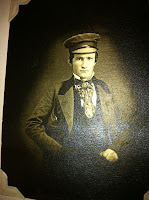 |
| S. Mariani & Sons at 23rd and Columbia (now Florida). See the children playing out front? One could be Vera! Photo used with permission of Carl Pisaturo- http://carlpisaturo.com/Carlovision_MAIN.html |
|
When Vera Mariani was a young girl, she lived on the corner
of 23rd and Columbia (now Florida) in San Francisco. Below her house at street level was her
father’s hardware store, S. Mariani & Sons.
The “S” stood for Stefano. The
sons were Helvetio, Walter, Arnold, Stephen and Eugene, although Arnold did not
make it to adulthood. Vera used to play
around the house and hardware store, exploring and making up games. The siblings closest to her age were her
brothers Steve and Gene. Once when my brother was terrorizing playing with me,
I remember Vera telling me that her brothers played too rough for her, too, and
that she often played alone.
It was
during one of these alone playing day that Vera opened the deep cupboard in the
kitchen that housed the ironing board. I
remember this cupboard. If you opened
the door, you could fold down the ironing board and reveal shelves. As she opened this one day, she saw something
on the top shelf. What was it? She retrieved the step stool and climbed
up. Grasping the edge, she pulled it and
then saw the well-recognized logo of Maskey’s Candies—a mask and a key.
San
Francisco was and still is known worldwide for its candy. From the 2000 National Register of Historic
Places Registration Form requesting that the Haas Candy Factory at 54 Mint
Street in San Francisco:
San Francisco possessed many favorable
characteristics for the success of the candy industry: the cool summer climate
is favorable for dipping chocolates. The deep water port facilitated
importation of cocoa beans and sugar cane. Sugar was refined locally as early
as 1857. The large population provided a good market for the product, which
included not only chocolates, but candy sticks, licorice, sugar plums,
lollipops, Turkish delight, ribbon candy, and taffy.
In
the 1887 Langley’s
San Francisco City Directory, Maskey’s was first listed as a
“manufacturer of fine candies.” (From http://archive.org/details/crockerlangleysa1897sanf). They are
no longer in business, but the location of the factory and store still stands at
48-52 Kearny Street.
When seeing that mask and key logo, young Vera must
have had a jolt of excitement, a Pavlovian response. Candy!
Right there! She opened the
carton and found that it was, in fact, a box full of chocolates. Of course no one would miss one tiny small
piece. She plopped it in her mouth,
savoring the delicious chocolate while she put the step stool and ironing board
away. A week or so later, she wondered
if the box was still there. She repeated
her adventure and found it was the same box with the one missing chocolate. Surely it had been forgotten. But if she were to point it out, she’d have
to share with her siblings. Best to keep
this to herself, she likely thought, as she popped another chocolate. This continued a few times, each visit emptying
the box by one chocolate.
On another note, outings with Father were very
treasured. He was a busy hardware man
and had sons to teach the business to and customers to care for. So one day, when Stefano asked Vera to come
along with him for a visit with his very best customer, she was excited. They rode the buggy over and upon reaching
the door, Stefano pulled out a box of Maskey’s chocolates for presentation to
the customer. “How lovely of you to
bring such fine chocolates,” said the customer.
Stefano bowed slightly in deference and with a touch of pride. Meanwhile, little Vera stood next to him,
shivering in horror and fear. It was THE
box. The half emptied box of Maskey’s
chocolates! She feared a whipping when
she confessed to Father, but instead just got lectured all the way home.
The part of this story that Louise told me that makes me the saddest is that I will never get to taste a Maskey’s
chocolate. If I did, I know I’d taste it
with the taste buds and excitement of the eyes of young Vera. I might even sneak them from my own cabinet,
just to experience that moment of hers. I
tried to find a picture of the Maskey’s logo online, but couldn’t locate
it. If anyone has it to share, I’d love
to see!
Note: The
Mariani family is not my blood family, but there are not many left of the
Marianis. I have deep
roots with the Marianis with my great grandfather and father both being
caretakers on their ranch in Portola Valley, as well as a house in Portola
Valley much later as I attended junior high and high school. Because of my love for my “Auntie Vera,” the
genealogist in me didn’t want to leave them untraced. So I have been researching them blindly (i.e.
only records, no ancestral stories) for about 3 years. Last
week I had the opportunity to meet with Louise, the 99-year-old granddaughter
of the immigrant Mariani, cousin to my Vera, who I remember well from my
childhood. She supplied me with
wonderful stories (including this one) and genealogy that I will be sharing
both here and in the book I’m writing.






